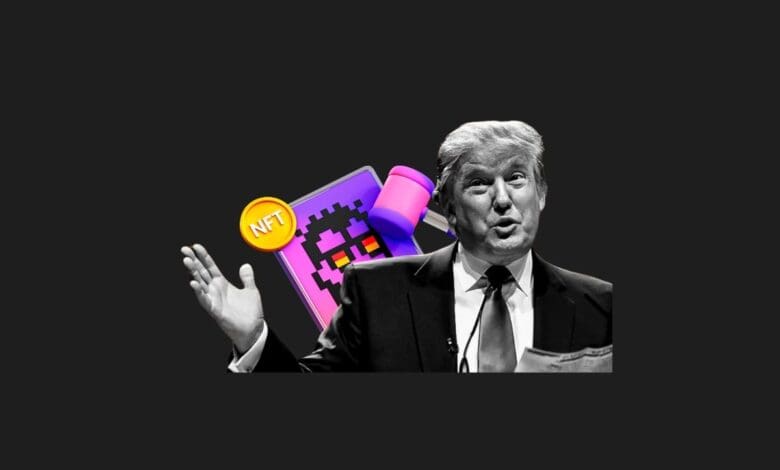Can Trump’s Trading Cards Revive NFTs in the Metaverse?

Less than two years after the collapse of the NFT market, Donald Trump is still selling his peculiar digital cards.
Last month, former U.S. President Donald Trump announced the launch of a new collection of digital trading cards.
The cards, announced on the Truth Social platform, are priced at $99 each. Buyers who purchase 15 or more cards will receive a physical card containing a piece of the suit Trump wore during his debate with President Joe Biden.
This isn’t the first time these cards have been sold. The initial collection in 2022 sold out within hours, generating total sales of 4.5 million dollars. This is also not the first time the presidential candidate has made a sales pitch to his loyal supporters.
Earlier this year, Trump sold coffee mugs, T-shirts, and business cards featuring his widely publicized mugshot taken at the Fulton County Jail.
These efforts seem more like the money-making tactics of a disgraced and cash-strapped candidate, rather than those of a so-called maverick billionaire.
While the concept of non-fungible token (NFT) collectible cards made sense as a value proposition in 2022—since they sold out—it’s unclear whether the latest collection is selling as quickly as the previous one.
Trump may boast, “They call me the crypto-president,” but while cryptocurrency was the darling of financiers in 2022 and NFTs were a hot topic, two years later, both conversations have largely faded into the background.

“NFTs surged and then collapsed in 2022 when people were stuck at home during COVID-19,” Dr. John Hawkins, a senior lecturer at the University of Canberra’s School of Politics, Economics, and Society, told Euronews Culture.
“Their value has not recovered,” Hawkins added. At its peak, the “market cap” of all NFTs was nearing a trillion dollars in 2022. Today, it is relatively close to zero.
The NFT market’s bull run between 2021 and 2022 peaked in August 2021, when weekly transactions reached $3.24 billion (111 billion TL). However, according to data from Block, only $67.93 million (2 billion TL) of transactions were recorded during the most recent week, from September 29 to October 6. That’s just over 2 percent of the volume seen three years ago.
Even Bored Ape, the most popular NFT collection promoted by celebrities such as Eminem, Post Malone, Madonna, and Paris Hilton, has seen a decline in sales, reflecting the general downward trend in the market.

At the time, Bored Ape NFTs were promoted as exciting investments in digital art with the potential for significant profits. However, the same celebrities quickly fell silent about their dazzling new NFTs.
What led to the sharp decline in these NFTs was the general public, drawn in by the promise of easy riches. With the value of Bored Ape and other NFTs plummeting, any hope of recovery has been dashed by cautious buyers.
“There are many buyers who got burned the first time and may be very hesitant to try again,” Hawkins noted. “But Bitcoin’s price has rebounded after previous crashes, so it’s not impossible.”
Bitcoin and other major cryptocurrencies have experienced wild market swings, but it remains to be seen whether NFTs will follow a similar path. Bitcoin continues to rise to new, eye-catching values, potentially making some technologists very wealthy.
Last year, crypto gambling specialist dappGambl published a study stating that 95 percent of all NFTs are now worthless investments, with few being purchased. In fact, 79 percent of NFTs remain unsold.
So why haven’t NFTs had the staying power of cryptocurrencies like Bitcoin? It likely stems from the criticism they received during their brief rise. While Bitcoin has a functional use case as an alternative currency, NFTs are essentially digital images that can easily be replicated and shared.
The claim of owning the “original” holds little weight. Its value is derived solely from the significance you assign to the prestige of owning it.

While some unconventional artists, such as Damien Hirst with his controversial work The Currency, created NFT artworks, most NFTs were simply non-artistic, childish graphics purchased by people hoping to strike it rich quickly.
Bitcoin’s rise is driven by the belief that it will become a legitimate financial instrument. NFTs, on the other hand, are largely art transactions for those unfamiliar with the true value of the medium.
This suggests that Trump’s latest desperate attempt to cash in on NFTs is unlikely to spark a resurgence. However, that doesn’t mean they won’t be financially rewarding for him, as Hawkins notes.
“Trump cards are different because they’re promoted by someone with a large fan base and media presence,” Hawkins explains. Yet, “ultimately, these are speculative assets with no underlying value and no cash flow generation.”
Still, Trump remains hopeful. There is one event that could significantly impact their price.
“If Trump wins, it’s much more likely that their value will increase,” Hawkins said.
You may also like this content
Follow us on TWITTER (X) and be instantly informed about the latest developments…










